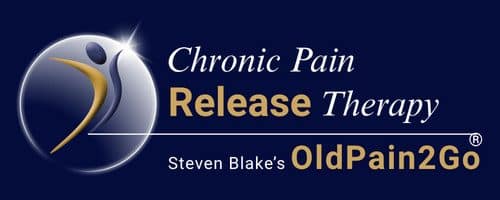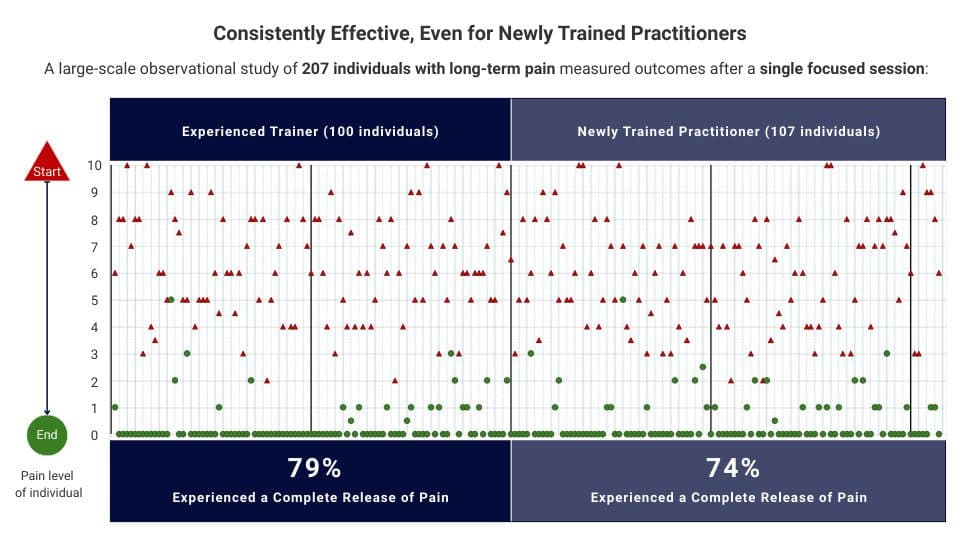
Research & Studies
We are dedicated to continuous evolution, constantly assessing effectiveness and accessibility. To date, our work has been supported by previous and ongoing university-led studies, as well as a comprehensive observational study, demonstrating a remarkable 76% efficacy in completely releasing long-term pain within a single session.*


University-led Research
An initial feasibility study of OldPain2Go®, conducted by Teesside University, Newcastle University, and the Norton Physiotherapy Centre, has been successfully completed and published in Pain and Rehabilitation, the journal of the Physiotherapy Pain Association.
Following the promising outcomes of this initial research, which concluded that further investigation into the efficacy of this intervention is warranted, a randomised, double-blind controlled trial is now underway, further evaluating the efficacy and safety of the OldPain2Go® approach within a clinical setting.



Drew Coverdale - Chartered Physiotherapist MSc BSc MCSP MMACP and author of The Pain Habit, with over 10 years’ experience in the NHS and another 10 years in private practice, shares his perspective:
"It is particularly promising to see these improvements occur within a relatively brief period of time and relatively short duration patient contact time of one hour per treatment session.
This has potential implications for service provision where resources are continually over stretched and provides justification for further exploration of this novel intervention.
These results demonstrate the feasibility and safety of recruiting to and delivering OldPain2Go®, for the treatment of pain and function, in people with CLBP [Chronic Lower Back Pain] within a research setting"
(Extract from the initial feasibility research paper summary, of which Drew was one of the authors).

Our large-scale observational study, currently pre-published and under peer review, involved 207 individuals experiencing a wide range of long-term pain types and locations, including fibromyalgia, arthritis, chronic back pain, and more, with an average pain duration of nearly 12 years, reflecting the real-world complexity of chronic pain.
Sessions were delivered by one of 108 trained OldPain2Go® practitioners across a variety of real-world settings, and the results were striking.
Outcomes:
◆ 76% reported a complete release of pain following a single session. (158 individuals)
◆ The remaining 24% (49 individuals) experienced an average reduction in pain of 78%.



The Complexity of Measuring Long-Term Outcomes
Similar to many healthcare services, this approach follows a Single-Session Therapy-inspired model, often achieving significant outcomes in just one focused session. While no formal follow-up process was in place at the time of the observational study, volunteers were given access to free follow-ups, and many were already known to us within the community. As a result, feedback on outcomes naturally took place through ongoing interactions.
Long-term outcome studies are currently planned, and we welcome further collaboration with researchers. However, studying chronic pain relief is inherently complex. Pain is not a static condition, it is shaped by a range of shifting biological, psychological, and social factors. This means that, in the future, pain may return if the brain perceives a new threat or reason to generate protective responses.
That said, clients typically leave sessions with a deeper understanding of how pain works and how to consciously engage their brain’s natural re-evaluation and reset processes. This increased awareness often empowers them to maintain their results and significantly reduces the likelihood of pain persisting or recurring.
Our Commitment to Collaboration and Progress
We are committed to continuous evolution and believe that collaboration is key to progress in this rapidly advancing field, an outlook reinforced by university-led research and a large-scale observational study, which highlight the broad applicability and transformative potential of our approach in addressing persistent pain.
Through collaborations with pain organisations, researchers, and scientific communities, we aim to deepen the understanding of pain release achieved through this innovative and effective release method. These partnerships play a vital role in bridging the gap between emerging research and practical, real-world applications, ensuring that advancements in pain science translate into accessible solutions for those in need.
We invite forward-thinking professionals to explore how this approach may enhance your area of specialty, whether through further research, supporting wider practitioner access, developing referral pathways for those in need, exploring our training programme, or simply endorsing this natural, effective alternative approach alongside medical or management-based options.

Creator and Director of OldPain2Go® Steven Blake, alongside Business Development Manager, Peter Dennis, at the 2024 International Association for the Study of Pain (IASP) World Congress, which celebrated fifty years of progress in pain science.
Recognising the widespread impact of the chronic pain epidemic on individuals, families, healthcare systems, and the global economy, alongside the rollout of the new chronic pain classification system and growing global awareness of advances in pain neuroscience, OldPain2Go® has expanded its reach to better meet this urgent need.
We were proud to exhibit at the 2024 International Association for the Study of Pain (IASP) World Congress, which celebrated fifty years of progress in pain relief. The event brought together over 3,500 scientists, clinicians, and healthcare professionals from around the world, representing a wide range of pain-related disciplines.
In a post-exhibition interview, IASP President Catherine Bushnell highlighted a major turning point in the field: (click here to see video)
“There is a big challenge in that opioids have been the primary treatment for pain, which is fine for acute pain, but for chronic pain, there’s many problems. So now we’re looking for other ways, non-drug ways, as well as other types of drugs to better treat pain.”


This global call for safer, more effective, non-drug approaches strongly aligns with our mission to deliver natural, communication-based solutions for long-term pain through trained practitioners worldwide.







